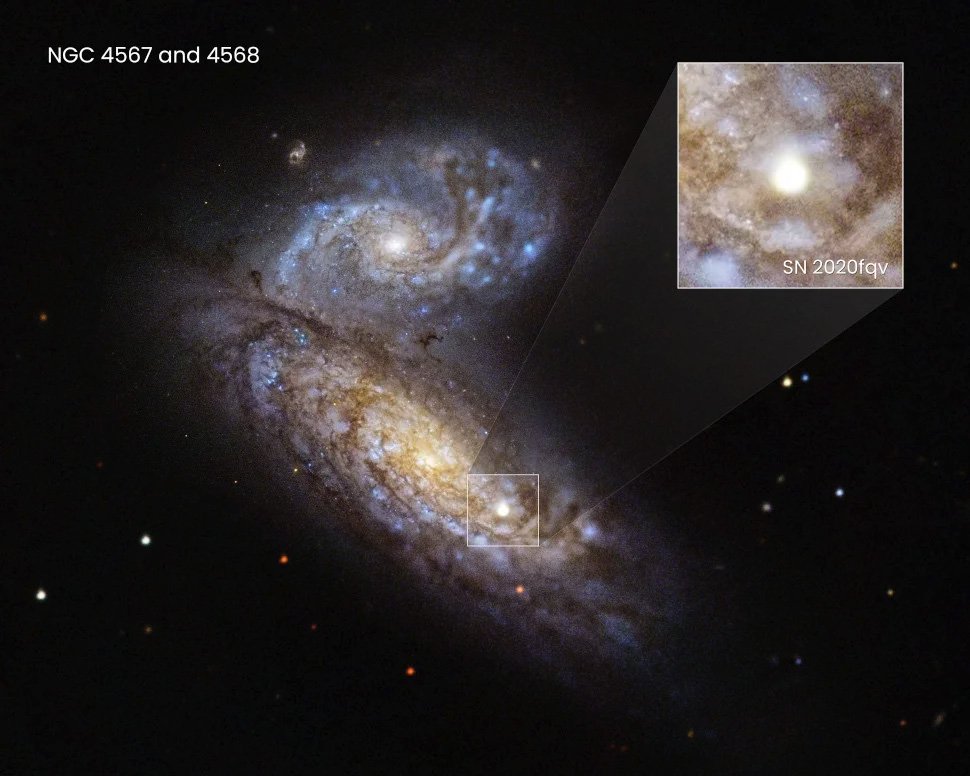
Several telescopes have detected a supernova explosion that illuminates the darkness of space 60 million light-years away. It is said that it was the first time in history that a dying star could be recorded so clearly and in real time.
The name given to the supernova explosion is SN 2020fqv. It was known to scientists right before the explosion, but it exploded without any contact in April 2020. It was observed by chance from Earth at the Zwicky Transient Facility (ZTF), an optical observation device at the Paloma Observatory in San Diego, California. Another thing I was looking at from space was the NASA TESS. Other astronomical observatories also participated in the observation one after another, and finally, multiple telescopes, including the Hubble Space Telescope, observed the end of SN 2020fqv on the ground and in space.
It is said that this is the first time that a supernova explosion can be observed from multiple perspectives and after the explosion itself. Images and data captured from multiple perspectives from the earliest stages are becoming important for deepening our understanding of the supernova explosion process and are expected to help predict when a supernova explosion will occur.
Watching stellar death and guessing the cause of death is no easy task. If an astronomer is compared to a crime scene investigator, so far, in the investigation of supernova explosions, after the death of the star, the astronomer has to run to the scene and infer what happened to the star from the evidence left behind. But one researcher said it was different this time because it was possible to observe what was happening in real time.
Since SN 2020fqv is 60 million light-years from Earth, the actual supernova explosion occurred 60 million years ago. So it’s not real-time in the real sense, but it’s meaningful enough.

SN 2020fqv is in two galaxies, NGC 4567 and NGC 4568, merged like a butterfly’s wings in the constellation Virgo. These galaxies will become one in a state of fusion. Following the ZTF and TESS, the Hubble Space Telescope began observing the star material surrounding SN 2020fqv a few hours after the explosion. Since then, the thinning of this stellar material in 2020 has been clearly documented, and new knowledge of post-supernova changes has been gained.
Immediately after a supernova explosion, the dense cast material is visible only for a short period of time. Therefore, it can only be observed infrequently. This is because it is usually observed for the first time a few days after a supernova explosion occurs.
It has long been known that stars become active when they die. Betelgeuse, for example, is expected to have a supernova explosion within the next 1 million years. However, there are many cases where it is not known exactly when the explosion will occur, and the signs are not clear. In this observation, from a few days before the explosion to several weeks after the explosion, TESS filmed SN 2020fqv at 30-minute intervals. The Hubble Space Telescope was also activated hours after the supernova explosion. Moreover, analysis of historical data dating back to 1990 revealed the appearance of SN 2020fqv dying over several decades.
So, what can we learn from this massive amount of data? One is that several astronomical techniques can be used to more accurately calculate stellar masses. According to this, the mass of SN 2020fqv at the time of the explosion was 14 to 15 times that of the Sun. The stellar physical conditions became clearer when a more accurate mass was determined to trigger a supernova explosion.
They also say that this observation could be the Rosetta Stone of a supernova explosion. It is an ancient Egyptian tombstone with the same content as the Rosetta Stone inscribed in three characters. It is a metaphor with the expectation that it will be a clue that reveals a mystery or hidden hint that has not been deciphered until now.
Based on these observations, it may be possible to build a supernova explosion warning system. Stars start to behave unusually and become strange, paying more attention to the signs that are still hidden at this stage, which may give us a better understanding of what’s going on before the star explodes. Related information can be found here.


















Add comment